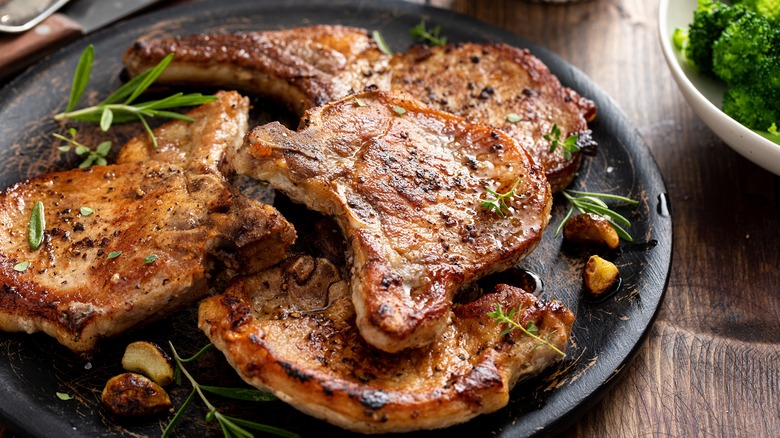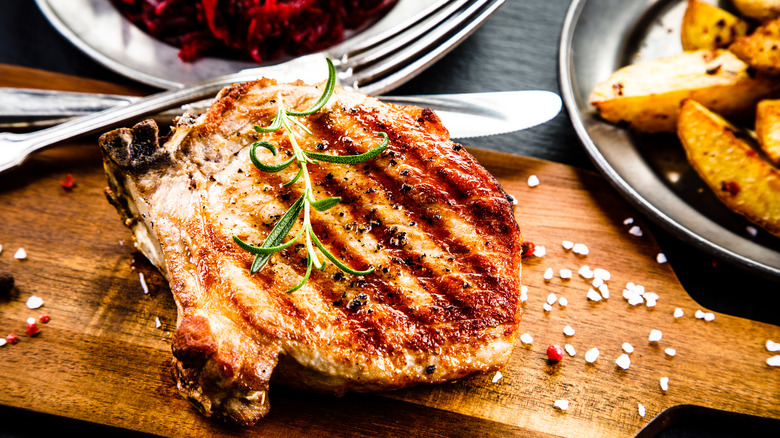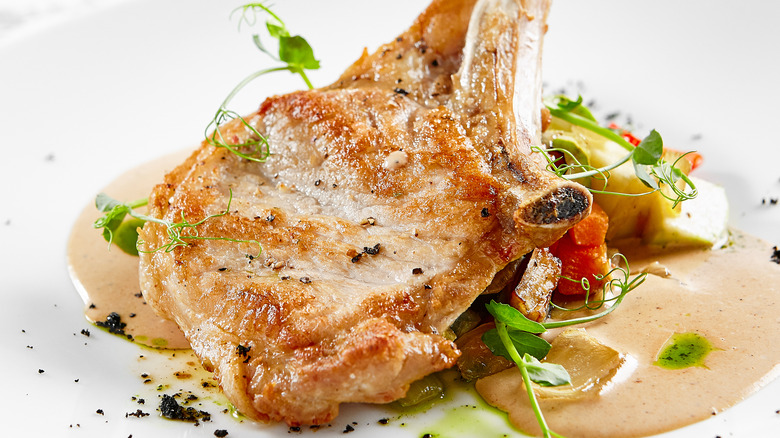To Brine, Or Not To Brine Pork Chops? We Have The Answer
No matter how you make your pork chops, whether you grill them, slow-cook them, or just toss them in the oven, the result should always be a juicy, tender piece of pork that melts in your mouth. It would make sense that you would want to focus on methods that would supposedly give you a juicier, richer flavor, such as brining for example.
Food Network's Cooking School describes brining as the "infusing proteins with salt, sugar, and other flavorings via the process of osmosis." A very good example of brining would be taking your pork chops and soaking them overnight in a plastic tub full of water and salt before putting them in the oven. The idea behind brining is that the liquid or solution moisturizes the meat, making it much more tender and juicy compared to a piece of meat that hasn't been brined. If you wanted to make a juicy pork chop, you'd probably be considering brining it as a simple and quick solution.
But if the brining process gives you a more tender piece of meat, why are there some people who argue against it? What are the arguments for brining and what are the arguments against brining?
Brining produces a juicy pork chop, but can also change the texture
It's not hard to see how brining would make your pork chop juicier. You put your pork chop into a tub of salty water. The water is reabsorbed and distributed throughout the meat. All that moisture compensates for the moisture and juices that are naturally lost during the cooking process and thus leads to a juicier piece of pork. Brining is no doubt one of many incredibly easy ways to get a juicy and moist pork chop, no matter what the cut.
But just as the introduction of all that moisture means that the pork chop will be much more tender, it also means that the texture will change too. Ella Quittner of Food52 notes that, while a brined pork chop is indeed incredibly juicy and tender, the excess moisture ruins any chance of the chop developing a crispy golden crust on the exterior. The pork chop will be very tender, but also very chewy and "wet," as trying to evaporate all that moisture would take a very long time. Even if you could get a caramelized exterior on your pork, you'll most likely have overcooked it trying to burn off the excess moisture.
The problem we have now is this: while brining can give you a juicier pork chop, it also affects its texture.
You can brine your chops for a few hours at most
While brining will always change the texture of your meat slightly, as it's the inevitable process of osmosis, that doesn't mean you can't reap the benefits of brining it without having to deal with mushy, overly chewy meat.
If you have particularly thick cuts of pork, such as bone-in pork chops, you will need to brine them for a considerable amount of time, albeit shorter than the usual brining time. It's a good idea to keep their brining time around the area of one to four hours at most. If you have thinner pork chops or ones that don't have any bones in them, you can brine them for anywhere between 15 or 30 minutes to a maximum of two hours. Not only do these shorter brining times means that you don't have to wait overnight or longer to prepare your meal, but it also prevents the solution from changing the texture of the meat too much. You may notice a slight change of texture in the finished dish, but you may still be able to develop a golden crust on the exterior more so than a pork chop that's been swimming in brine all night.
Another good rule to remember when brining your pork is to ensure that the meat is as dry as possible, or at least not drenched in brine before you cook them.


